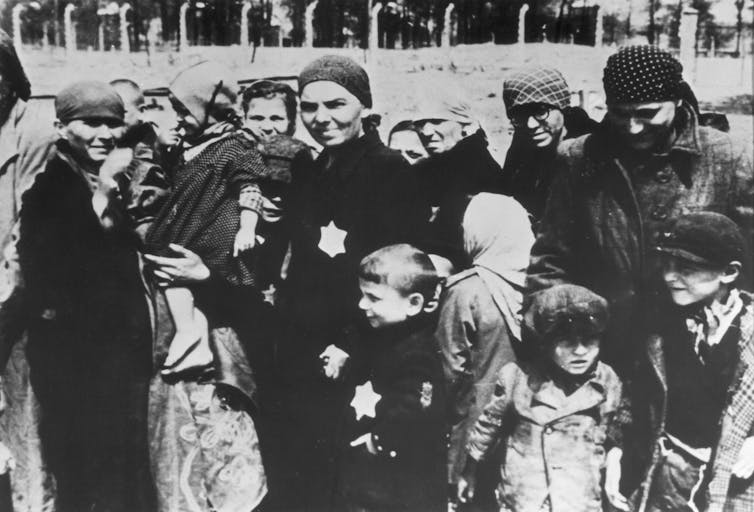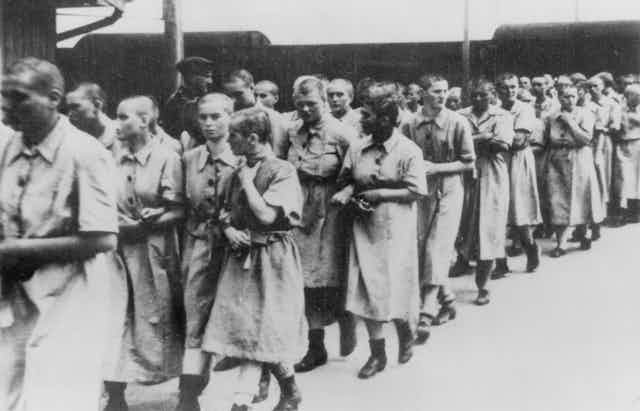Nearly all the 1.3 million people sent to Auschwitz, the Nazi death camp in occupied Poland, were murdered – either sent to the gas chambers or worked to death. Life expectancy in many of these camps was between six weeks and three months.
Over a million of the Auschwitz dead were Jews, and scholars have concluded that more than half of them were women.
While male and female slave laborers in Auschwitz faced the same ultimate fate, my research on gender and the Holocaust finds that some of their behaviors and responses to captivity differed.
Methods of sabotage
Gender has been long overlooked in Holocaust research. Writing in the late 1970s and early 1980s, early scholars such as Joan Ringelheim and Sybil Milton had to fight for their legitimacy in a field that insisted that separating stories of Jewish men and women under the Nazi regime was a blow to their joint fate or to Jewish solidarity.
Today, however, the topic is being explored in depth, allowing us to better understand not only how Jews died during the Holocaust, but also how they lived.

During the late 1980s, I conducted a study of Jewish men and women who had been part of Auschwitz’s “Canada Commando,” the forced labor detail responsible for sorting through the possessions inmates had brought with them to the camp and preparing those items for reshipment back to Germany for civilian use.
Since the barracks were the only place in the camp where one could find almost unlimited food and clothing, this forced labor troop was named after Canada – a country seen as a symbol of wealth.
Examining the behavior of the men and women of the Canada Commando, I noted an interesting difference. Among the items of clothing sorted there were fur coats. While both male and female prisoners in the Canada Commando tried to sabotage this work, acts punishable by death, their methods differed.
Male prisoners would usually rip the lining and seams of the coat to shreds, keeping only the outer shell intact. At first use, the coat would come apart, leaving the German who wore it coatless in the winter.
The few surviving women in the commando whom I interviewed did not use this tactic. Rather, they told me, they decided together to insert handwritten notes into the coat’s pockets that read something along the lines of: “German women, know that you are wearing a coat that belonged to a woman who has been gassed to death in Auschwitz.”
The women, in other words, chose psychological sabotage. The men, physical.
Coping with hunger
One of the most central experiences of all camp prisoners during the Holocaust was hunger. While both men and women suffered from hunger during incarceration, male and female prisoners used disparate coping methods.

While men would regale each other with tales of the fantastic meals they would enjoy once liberated, women would often discuss how they had cooked the various dishes they loved before the war, from baking fluffy cakes to preparing traditional Jewish blintzes. Cara de Silva’s 1996 book, “In Memory’s Kitchen,” movingly documents how this phenomenon played out among women prisoners in the Terezin camp.
The differences between men’s and women’s coping methods may have derived from the gendered behavior in their lives before the war, in which men ate and women cooked – at least in the middle and lower classes.
In the case of women, this may also have been a female socialization process meant to solve two dilemmas simultaneously: the psychological need to engage – at least verbally – with food, and the educational need to prepare the young girls in the camp for culinary and household tasks after the war.
Under normal circumstances, mothers would have taught their daughters by example – not story.
Motherhood under Nazi rule
Various historical studies make mention of motherly sacrifices during the Holocaust, such as women who chose to accompany their children to death so that they would not be alone during their last moments on Earth.

Some mothers, however, acted otherwise, as documented by the Polish non-Jewish Auschwitz survivor Tadeusz Borowsky in his book “This Way to the Gas Ladies and Gentlemen.”
During the “selections” at Auschwitz – when prisoners were sent either to live or die – prisoners arriving were usually divided by sex, with the elderly, mothers and small children being separated from men and older boys. The mothers with small children, along with the elderly, were automatically sent to death.
Borowsky writes about a number of young mothers who hid from their children during the selection, in an attempt to buy themselves a few additional days or possible hours of life.
If a German soldier found a small child alone at a “selection,” Borowsky writes, he would take the child up and down the rows of prisoners while screaming, “This is how a mother abandons her child?” until he tracked down the hapless woman and condemned them both to the gas chambers.
At first, the female Auschwitz survivors I’ve interviewed said they’d never heard of any such thing. Eventually, however, after I returned to the question several times via different topics, a few women admitted to hearing that a handful mothers who arrived in Auschwitz with small children did indeed try to hide to save their own lives.
Historians are not judges. I do not mention the actions made in mortal fear to condemn these women but rather to contribute, 75 years later, to our understanding of Jewish life and death under Nazi terror. Doing requires relinquishing preconceived notions about both men and women, mapping out a broader canvas of the grim reality at Auschwitz.
[You’re smart and curious about the world. So are The Conversation’s authors and editors. You can get our highlights each weekend.]

